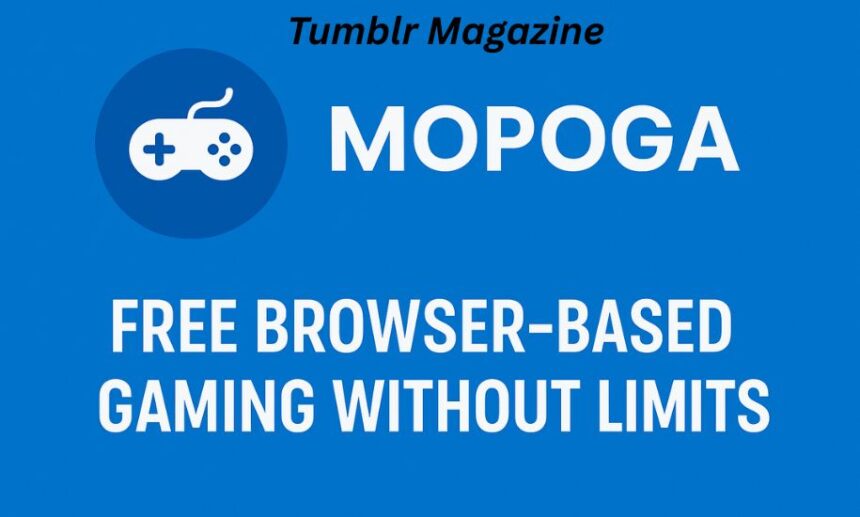The landscape of gaming has shifted dramatically over the past two decades. What was once restricted to bulky consoles, CDs, or expensive gaming PCs has now spread across smartphones, tablets, and—most recently—browser-based platforms that deliver instant, no-download entertainment. Among the names surfacing in this space is Mopoga, a free-to-access online gaming hub that promises “gaming without limits.”
For casual players and even seasoned gamers seeking quick fun, Mopoga positions itself as a destination to jump into digital worlds without installation, registration hurdles, or high system requirements. However, as with many rapidly rising online platforms, Mopoga’s brand identity is fragmented, its reputation varies depending on the domain, and its content range includes both family-friendly casual titles and NSFW material.
This article explores Mopoga in depth—its features, promises, challenges, and controversies—while situating it within the broader trend of instant-play gaming.
What Is Mopoga?
At its core, Mopoga is described across various blogs and official-looking websites as a browser-based gaming platform. Unlike traditional gaming ecosystems where you must download a client or purchase titles, Mopoga provides instant access to a wide range of games directly through a web browser.
The platform is typically promoted as:
-
Free to play: Users don’t need to buy licenses or install apps.
-
Ad-supported: The service is sustained by advertisements rather than upfront costs.
-
Cross-device: Accessible on desktops, tablets, and mobile phones.
-
Casual gamer-friendly: Games range from puzzle and racing to lightweight multiplayer formats.
Some Mopoga-branded sites describe themselves as communities, encouraging players to compete on leaderboards or share feedback, while others position Mopoga more as a portal that aggregates browser-friendly HTML5 and WebGL games.
The Mopoga Brand Fragmentation
One of the most interesting—and confusing—aspects of Mopoga is that its name is used across multiple domains.
-
mopoga.com – A central hub with FAQs, but also containing adult-oriented links such as “AI Porn” sections.
-
mopoga.blog – A blog-style site that publishes informational articles like “What is Mopoga?” and “The Future of Browser Gaming.”
-
themopoga.net – Offers “About” and “Contact” pages, pitches Mopoga as a fast, ad-supported experience, and runs a blog for updates.
-
the-mopoga.com and themopoga.com – Satellite pages, often framed as guides, marketing pitches, or “complete introductions.”
This fragmentation raises questions about authenticity. Are these sites part of one coordinated brand strategy, or are they opportunistic SEO-driven clones capitalizing on the keyword? For readers, the key takeaway is this: not every Mopoga-branded site delivers the same type of experience or content, and some can be inappropriate for younger audiences.
How Mopoga Works
From a user’s perspective, Mopoga promises an ultra-simple entry point:
-
Open the browser (Chrome, Firefox, Safari, or Edge).
-
Visit a Mopoga domain.
-
Click to play—no downloads, patches, or logins required.
Technically, most Mopoga games rely on HTML5, WebGL, or cloud-streaming technologies, which allow graphics and gameplay to be delivered directly over the web. This design aligns with the modern push for low-storage solutions—perfect for users on budget smartphones, shared devices, or those who want a quick distraction without commitment.
Game Library and Genres
While Mopoga does not publish a transparent game catalog, promotional blogs and FAQs highlight the following types of titles:
-
Casual puzzles – e.g., matching games, sudoku-style logic puzzles.
-
Arcade classics – simple, reflex-driven gameplay like Slither.io or Cookie Clicker.
-
Simulation and builder games – examples include Townscaper and sandbox-inspired mini-games.
-
Racing and sports – quick matches that don’t require complex controls.
-
Multiplayer lobbies – lightweight social or competitive games with real-time leaderboards.
The focus is less on immersive AAA-quality graphics and more on snappy fun, mirroring the success of app-store casual hits like Flappy Bird or Subway Surfers.
Features Highlighted by Mopoga Blogs
Across its ecosystem of domains, Mopoga is promoted with several recurring selling points:
-
Instant Play – No downloads or updates.
-
Free Access – Games supported by ads, not paywalls.
-
Variety – Titles span multiple genres, appealing to both children and adults.
-
Cross-Device Compatibility – Seamless switching between phone, tablet, or desktop.
-
Community Angle – Some blogs emphasize leaderboards, high scores, and future social integration.
It’s worth noting that while these claims are widely repeated in Mopoga-related blogs, first-hand testing may show uneven performance, as some games can be laggy or riddled with heavy ad interruptions.
The Pros of Mopoga
-
Accessibility for Everyone
Anyone with an internet connection and a browser can dive in. This democratizes gaming for users who may not afford consoles or high-end PCs. -
No Storage Burden
Mopoga appeals strongly to users with limited storage, especially budget smartphones common in emerging markets. -
Variety and Flexibility
Instead of downloading dozens of apps, a player can explore multiple genres from a single portal. -
Completely Free
While ad-supported, the absence of upfront costs lowers the barrier to entry compared to app stores or Steam.
The Cons and Risks of Mopoga
-
Advertisement Overload
The biggest user complaint is intrusive ads. Many titles are punctuated by pop-ups or banners, which can hurt immersion. -
Always-Online Requirement
Unlike installed games, Mopoga games require a constant internet connection. This makes offline play impossible. -
Privacy Concerns
As with any ad-driven platform, data collection is a possibility. Without a clear privacy policy across its fragmented sites, users should remain cautious. -
NSFW Content
Perhaps the most significant issue: certain Mopoga-branded domains openly promote adult content. This makes Mopoga unsafe for unsupervised minors and raises questions about brand identity.
Mopoga and the Broader Trend of Instant-Play Gaming
Mopoga’s emergence is not in isolation. It represents a broader shift toward frictionless gaming. Competitors like CrazyGames, Poki, and Kongregate also dominate this space, offering free HTML5 libraries. Mopoga’s unique value, however, lies in its aggressive branding across multiple domains and its pitch as a “no-limits” alternative.
From a tech standpoint, platforms like Mopoga illustrate how cloud streaming and web standards are converging. As 5G and fiber networks become widespread, the dream of console-level experiences streamed instantly through browsers is becoming more realistic. Mopoga taps into that hype, even if its execution is currently closer to casual mobile gaming than AAA blockbusters.
Safety and Best Practices for Users
If you or your readers are curious about trying Mopoga, it’s important to balance curiosity with caution:
-
Stick to safer domains – Mopoga.blog and themopoga.net lean toward informational and family-safe content. Mopoga.com, in contrast, includes NSFW material.
-
Use ad-blockers if allowed – This can cut down on intrusive interruptions, though it may break some games.
-
Avoid sign-ups – Unless you fully trust the domain, don’t share personal information.
-
Supervise kids – Given the adult content risk, Mopoga is not safe for unsupervised minors.
The Future of Mopoga
The long-term future of Mopoga depends on whether it can consolidate its brand, improve trust, and address safety concerns. If Mopoga (or whichever entity operates its core domains) manages to position itself as a clean, reliable hub with partnerships from legitimate game developers, it could carve out a significant share of the casual gaming market.
However, if the brand continues to fragment across multiple domains—some pushing family games, others promoting adult content—it risks eroding credibility and confusing users.
That said, Mopoga embodies an undeniable shift: gaming is moving toward instant, no-commitment platforms, and Mopoga is one of the clearest case studies of both the opportunities and pitfalls of that model.
Conclusion
Mopoga is more than just a quirky keyword floating around blog networks—it’s a window into the future of browser-based gaming. By offering free, instant, and cross-device play, it appeals to a global audience seeking quick entertainment without downloads or paywalls. But with its ad-heavy structure, privacy uncertainties, and NSFW associations, Mopoga is far from a risk-free option.
For writers, developers, and gamers, Mopoga raises vital questions about the sustainability of free gaming, the dangers of fragmented branding, and the blurred line between mainstream and adult entertainment online. Whether Mopoga matures into a trusted name or fades as an SEO-driven experiment, its story is worth watching.
And if you’re reading this on Tumblr Magazine, you now have the full picture.







